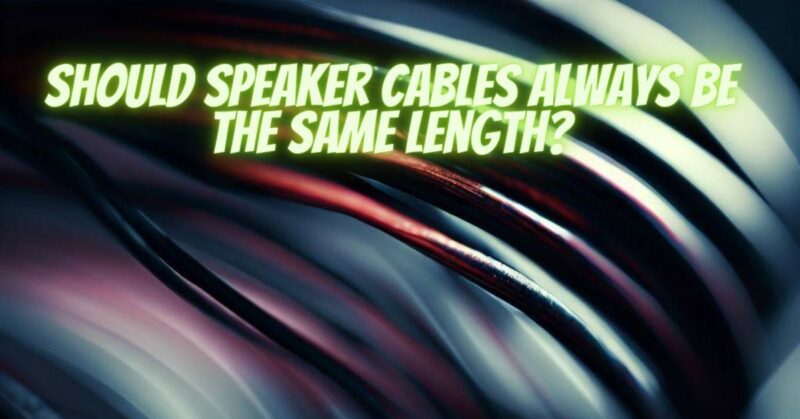When setting up a speaker system, achieving balanced audio performance is a key objective. One aspect that often raises questions is whether the speaker cables should always be the same length. In this article, we will explore the considerations surrounding speaker cable length and discuss the potential impact on audio quality and system performance.
- Signal Timing and Phase Alignment: Audio signals travel through speaker cables at a finite speed. When speaker cables of unequal lengths are used, the signals from the amplifier to the speakers may experience slight delays, resulting in an imbalance in signal timing and phase alignment. This can affect the stereo imaging, soundstage, and overall coherence of the audio playback. Keeping the speaker cables the same length helps to maintain proper signal synchronization and preserve the integrity of the audio reproduction.
- Impedance Matching: Speaker cables, along with the speakers themselves, contribute to the overall electrical impedance of the system. Impedance mismatches can lead to inefficient power transfer and potentially affect the frequency response and damping characteristics of the speakers. While the cable length alone does not directly impact impedance matching, using cables of equal length for each channel ensures consistency and helps maintain the desired electrical characteristics across the system.
- Cable Resistance and Voltage Drop: Speaker cables have a certain amount of resistance, and longer cables typically have higher resistance values. As the length of the cable increases, so does the potential for voltage drop along the cable. If the speaker cables are of unequal lengths, the speakers farther from the amplifier may experience a slightly lower voltage level, resulting in an imbalance in sound output. By keeping the cables the same length, you can mitigate potential voltage drop discrepancies and maintain consistent audio levels across the speakers.
- Practical Considerations: While using speaker cables of equal length is ideal, it may not always be feasible due to room layout, speaker placement, or other practical constraints. In such cases, the difference in cable length should be kept minimal to minimize any potential adverse effects. Additionally, choosing high-quality, low-resistance speaker cables can help mitigate voltage drop and signal degradation even with slight variations in cable length.
- System Calibration and Room Correction: Modern audio systems often incorporate calibration tools and room correction algorithms to optimize the sound output. These systems can help compensate for minor variations in speaker cable length and other acoustic factors. By calibrating the system and applying room correction techniques, you can fine-tune the audio performance and mitigate any potential negative effects arising from slight cable length differences.
Conclusion:
While it is advisable to keep speaker cables the same length for optimal audio performance, minor variations in cable length can often be compensated for through system calibration and room correction. However, significant differences in cable length can result in signal timing issues, impedance mismatches, and potential imbalances in sound output. Striving for equal cable lengths helps maintain proper signal synchronization, impedance matching, and consistent audio levels across the speakers, ensuring a balanced and immersive listening experience.


